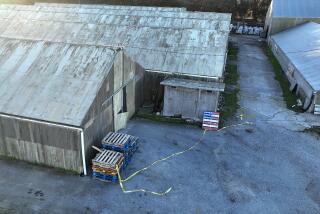Bat Census Will Help Crews Relocate Colony in Topanga
The usually staid state and county bureaucracy is going absolutely batty.
In May, a state agency is going to conduct a census of bats to find out just how many of Dracula’s alter egos hang out in the part of Topanga Canyon where the count (the numerical kind) is to take place.
And a project to replace an aging wood bridge--under which hundreds of bats sleep the day away--has been delayed a year so temporary homes can be established for the creatures.
The new bridge is to be made of concrete, which ordinarily would deprive the animals of a nap-time claw hold. But the replacement bridge will also be bat-friendly, with wooden “bat crevices” attached to its underside.
Although jokes about all this are inevitable, biologists and naturalists are delighted with the decision by the Los Angeles County Department of Public Works to fund its first bat project.
*
It all began two years ago when the department announced plans to replace a 70-year-old bridge, one of three timber spans in the canyon where colonies of bats have quietly dwelt for decades.
But conservationists voiced concerns about tossing all those bats out of their homes.
So county, state and federal officials spent months putting their heads together with biologists and residents, figuring out how to bridge the bat issue. They finally came up with a very complex, far-reaching plan that even incorporates the bat’s gestation cycle. An official census is part of the agreement.
The bridge project was to begin this month(April), but because of the issue’s complexity, it has been postponed until next April.
“We’ve actually gotten Public Works to become critter friendly,” said Rosi Dagit, a biologist with the Santa Monica Mountains Resource Conservation District, which will conduct the bat census May 17.
A team of biologists and about two dozen volunteers will participate in the count, which aims to tally every bat at each of the three wood bridges.
Leaders of the project decline to specify the locations of the spans because they fear that the bats will be harmed by vandals or disrupted by visitors.
Census takers, who range in age from 7 to 70, will each be assigned a section of a bridge. With a Tally Wacker in hand--a clicker used to count quickly with the thumb--they will attempt to count the bats as they emerge from their roosts at dusk.
Participants will “have to be in place, sitting very quietly before dusk, so they don’t disturb the bats,” Dagit said. “Bats are very sensitive to noise and won’t fly” if they suspect they are being watched by humans.
Census takers will also have to be fast. The bats “come out by the hundreds, all at once,” said Sooki Wheeland, an artist and bat fancier who lives near one of the bridges. She will be among the counters, who expect to complete their tally by 9 p.m.
“What we love about where we live is that we can eat outside in the evenings and never seem to have an insect problem,” she said, crediting the bats. Bats live on insects they snap up on the wing, homing in through the dark with their own natural sonar.
Biologists want to learn not only how many bats populate the bridges, but also what species are there. A graduate student from Cal State Fullerton will record the creatures’ high-frequency squeaks, which can be used to identify species, Dagit said.
The most common species in the canyon--the Mexican free-tail bat--is well known, said Diana Simons of Pasadena, a bat biologist for the U.S. Forest Service and a consultant for the Topanga census.
Bats--the only mammals that fly--can each eat 3,000 insects a night, Simons said. “They really are beneficial animals that people know very little about.”
The creatures are expected to play a particularly important role this year in combating an explosion in the populations of mosquitoes and other insects as a result of heavy rains and abundant standing water.
The attention the bat project is getting in bohemian Topanga was evident last month when more than 200 parents and children crowded into a presentation on the creatures at Topanga Elementary School. The star attraction was Rocky, a Mexican free-tail that Simons has nurtured for two years. The animal’s wing was permanently disabled by a startled homeowner who swatted it with a baseball bat during an encounter in a garage, she said.
County officials announced the bridge replacement project at a gathering of residents two years ago. They were unaware of the bats’ existence until one man in the audience jumped up and yelled, “Hey, what about the bats living under the bridge?”
The question stymied officials and set the conservation-oriented audience atwitter.
“That got everybody kind of excited,” said homeowner Grant Brosius, who has lived with his wife, Cheri, in a small rustic cabin near the bridge since 1994. “I felt a little embarrassed, jumping up like that, but I felt the issue was important, that we need the bats to take care of the insects.”
*
Since then, dozens of residents, officials and agencies have been involved in resolving the issue. Plans for a new bridge with bat crevices were designed by the California Department of Transportation, modeled after similar bridges in Texas.
The total bridge replacement project is expected to cost about $300,000, county officials said. Of that, $3,200 was allocated for bat preservation, including sponsoring the school presentation and providing census materials.
The bat census will be repeated next fall and in the winter to monitor the creatures’ movements.
Biologists will use netting to bar the bats from the project bridge next spring, so that none will be injured when the wood span is torn down. In the meantime, “bat houses” made by Topanga Cub Scouts will be set up near the bridge in the hope that the bats will temporarily move in.
“It has been a very large cooperative effort,” Dagit said.
“Initially, Public Works looked at us and said, ‘You want what?’ But eventually the loop got closed.”
(BEGIN TEXT OF INFOBOX / INFOGRAPHIC)
Bat Census
Biologists and volunteers will station themselves at dusk on May 17 to count the number of bats emerging from roosts under three aged timber bridges in Topanga Canyon. It’s the first such bat census to be undertaken here. Results will be used to help temporarily relocate bats for reconstruction of a bridge next year.
Mexican Free-tail Bat
Tadarida brasillensis
* Size: Length: 3 1/2-4 inches; wingspaj, 11-13 inches.
* What to look for: Long tail; flight is high, straight, fast
* Color: Dark brown or dark gray above, with whitish hairs underneath
* Habitat: Roosts in buildings and caves
More to Read
Start your day right
Sign up for Essential California for news, features and recommendations from the L.A. Times and beyond in your inbox six days a week.
You may occasionally receive promotional content from the Los Angeles Times.






